#friedrich von hardenberg
Explore tagged Tumblr posts
Text
Goethe: Listen, kid. I had a long talk with Fritz today.
Novalis: Uh-huh.
Goethe: Well, the thing is...I think I have a little crush on him.
*Schiller suddenly enters dramatically*
Schiller: I'm so happy! My world suddenly has meaning!
Novalis: This is the man you have a crush on?
#source: seinfeld#johann wolfgang von goethe#friedrich von hardenberg#friedrich von schiller#schoethe#incorrect german romanticism quotes
17 notes
·
View notes
Text



Zwei alte Herren auf der Bank in Weißenfels.
2 notes
·
View notes
Text
@poesia-storica if you know, you know. just saying he would totally have a squirrel.
Peanut the rescued squirrel
Peanut
34K notes
·
View notes
Text

“Wir träumen von Reisen durch das Weltall – ist denn das Weltall nicht in uns? Die Tiefen unsers Geistes kennen wir nicht – Nach innen geht der geheimnisvolle Weg. In uns, oder nirgends ist die Ewigkeit mit ihren Welten – die Vergangenheit und Zukunft.”
“We dream of travels throughout the universe: is not the universe within us? We do not know the depths of our spirit. The mysterious path leads within. In us, or nowhere, lies eternity with its worlds, the past and the future.”
— Novalis (Friedrich von Hardenberg)
Philosophische Gespräche mit Jochen Kirchhoff Episode 37 vom 12.November 2023 mit Gwendolin Walter-Kirchhoff: https://youtu.be/I8YXD47lzpg?si=iJiDqnCD1zbMZ5e2
#Novalis#Friedrich von Hardenberg#Deutsche Literatur#Poesie#Romantik#Jochen Kirchhoff#Deutsche Romantik
1 note
·
View note
Photo

Novalis, Heinrich von Ofterdingen: A Romance [originally published 1802]
#novalis#literature#words#quotes#academia#dark academia#quote#lit#books#love#books and libraries#reading#georg philipp friedrich freiherr von hardenberg#june#quote of the day#bookworm#book quotes#prose#booklr#bibliophile#excerpt#q
9K notes
·
View notes
Text
He would. He definitely would. He just has that thing of just being really good at describing people.
OK here's a new icon game: would you trust your icon to interpret your character correctly if you were fictional?
#friedrich von hardenberg#i love his writing#he reminds me of myself#hence why i named myself novalis#and so i trust him#don't worry fritz#you've got this
11K notes
·
View notes
Text

It is the most arbitrary prejudice is to deny the human the capacity of transcending his self, of being aware of that which lies beyond the immediate senses. One needs at any moment to be a transcendent creature. Without this one would never be a citizen of the world, one would instead be a mere animal. Of course, prudence, self-discovery, is very difficult in this state, since it is so incessantly associated with the change of our other circumstances.
—Friedrich Freiherr von Hardenberg (Novalis), Blüthenstaub-Fragment § 22 (1797). Below: Caspar David Friedrich, The Monk by the Sea (1810)
(Robert Scott Horton)
13 notes
·
View notes
Text
Where are we really going? Always home.
— Novalis (aka Georg Philipp Friedrich Freiherr von Hardenberg), “Hymns to the Night” (original title: “Hymnen an die Nacht”). (Friedrich Schlegel in the Athenaeum, 1800)
21 notes
·
View notes
Text
The session of plenipotentiaries that never happened,
Or The tale of how I rediscovered that one lithography of Isabey’s famous painting in extremely high resolution and went through a total recall, so that everybody could suffer (myself including) ⭐️
The arrival of the Duke of Wellington had not only affected Vienna's diplomatic activity and social calendar; it was also posing a problem to the painter Jean-Baptiste Isabey, who was trying to capture the congress on canvas. He had been working for some time, and he had finally found a way to balance all the strong personalities, many of them patrons, into one single painting, and yet not offend national sensibilities or fragile egos.
The painting, which depicted the delegates gathered in a conference room, turned out to be a compromise in the best spirit of Vienna diplomacy.
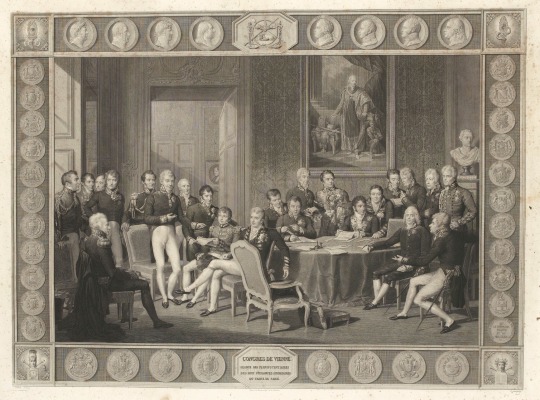
Metternich, the president of the Congress, draws the eye, as the only standing figure in the foreground.
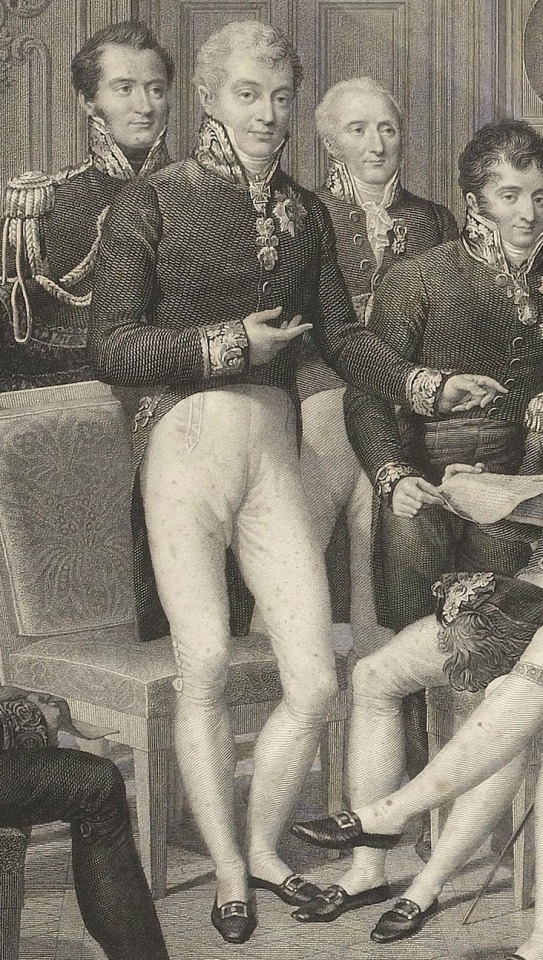
Castlereagh, though, commands the center, sitting with his legs gracefully crossed and elbow resting on the table.
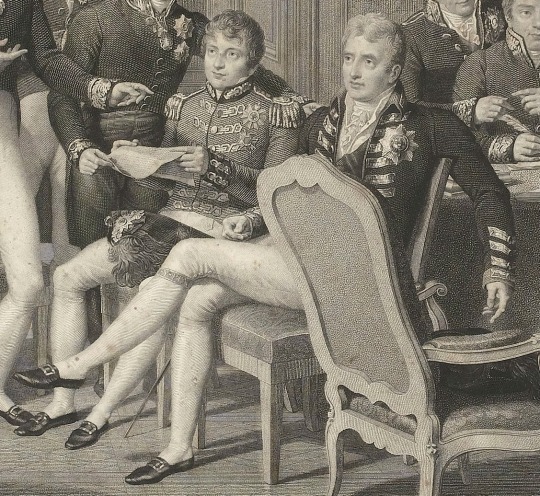
The light shining through the window, however, falls onto Talleyrand, sitting across the table with his dress sword at his side. An empty chair on both his right and left make him further stand out, as do the nearby figures who look to him, just as many of the smaller powers had sought his leadership the last few months.

As Isabey was putting the finishing touches to his composition, he had to figure out what to do about the fact that the Duke of Wellington was now also in town. Starting over was out of the question. Omitting a man of his stature was equally impossible. Yet it was not easy to incorporate him into a canvas on which all the best places had already been taken. The painter's solution was simple and elegant: why not make the painting commemorate the Duke of Wellington's arrival in Vienna?
That way, the duke could simply be inserted on the far left side of the painting, without any insult to his position. As for the duke's reluctance to be painted from a side angle (he was self-conscious about his nose), Isabey had overcome that with a well-targeted compliment: didn't Wellington look like the handsome and chivalric Henry IV? Pleased with this comparison, Wellington accepted, joking that Isabey was a "good enough diplomat to take part in the Congress".
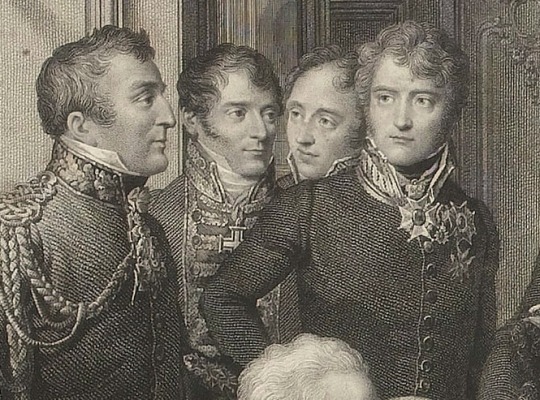
The painter also had to apply his finesse to convince Humboldt to enter the studio. The Prussian ambassador hated to have his portrait made, and, sure enough, he first declined, claiming that he had "too ugly a face ever to spend a penny" on a portrait. With this statement, Isabey saw his opportunity and emphasized that he would not "ask the slightest recompense for the pleasant trouble I am going to take". Isabey only wanted "the favor of a few sittings".
"Oh, is that all?" Humboldt quickly came around when he realized it would not cost him anything. "You can have as many sittings as you like".
Later, many congratulated Isabey on his portrait, particularly the fine job with Humboldt. The Prussian did not pay anything, as agreed, and Isabey got his revenge, Humboldt joked, by painting "an excellent likeness of me".
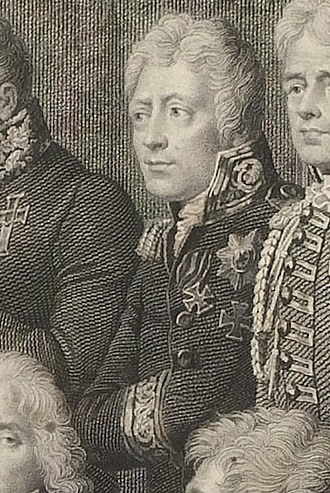
Few could complain of the treatment received from Isabey's flattering brush. This famous painting of the Congress of Vienna was pleasing to all, though typical of this peace conference, the scene was purely imaginary. The group of twenty-three delegates had never met in exactly this way before. Isabey had painted the portraits of each figure individually, and then later assembled the whole group together.
And so, symbolically, this simulated image would commemorate a congress that never was.
After that spectacular depiction of historical context surrounding Isabey’s magnificent canvas by David King few things are left to be added. I would simply love to highlight some other figures of utmost importance for the diplomatic life of that illustrious historical period - there are
Karl August von Hardenberg, Prime Minister of Prussia at the time;
Herren Wacken and Friedrich von Gentz, two Secretaries who were responsible for the protocols of the most important Congress' meetings;
count Karl Vasilyevich Nesselrode, a Russian-German diplomat, who became state chancellor of the Russian Empire in 1816;
prince Andrey (Andrew) Kirillovich Razumovsky, an extremely wealthy Russian aristocrat and diplomat, for whom Vienna was like his second home;
and we shouldn’t (or rather can’t) forget about general Charles Stewart-Vane, Castlereagh’s younger brother who definitely knew how to throw an unforgettable party, so refined aristocratic society could discuss his wild adventures at their fashionable salon meetings day and night. ✨
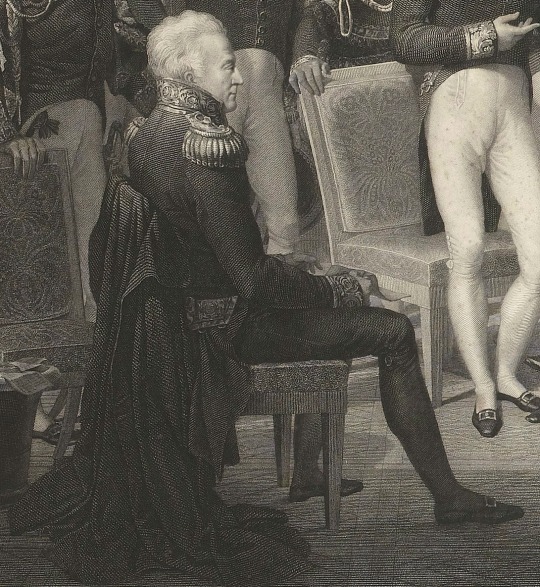

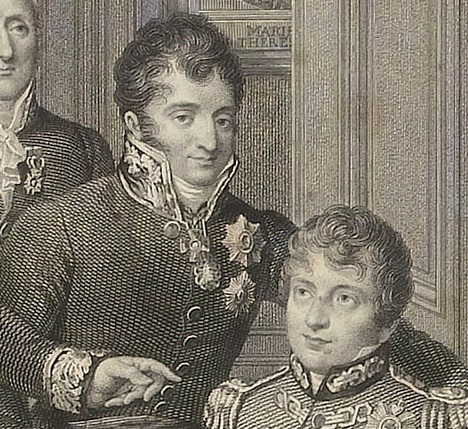
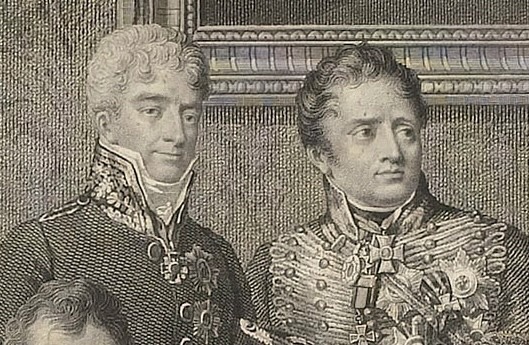
P.S.
Perhaps, there should be more posts with other details of the lithograph as well as Isabey’s original canvas, I’ll just need some time and motivation for that. 👌
#I bet some people know perfectly well what was playing in the background during the arrangement of this post 🤫#the congress of vienna#klemens von metternich#metternich#robert stewart#lord castlereagh#charles-maurice de talleyrand-périgord#talleyrand#wilhelm von humboldt#humboldt#hardenberg#friedrich von gentz#nesselrode#prince razumovsky#charles stewart-vane#napoleonic era#napoleonic wars#19th century#1814#1815
55 notes
·
View notes
Text
Schlegel: Fighting with my brother about which fruit would win if they were sentient and could fight.
Kleist: Obviously pineapple.
Achim: Except coconut would kick its ass...
Heine: Uh...have you seen a durian before?
Schiller: Dragonfruit is the obvious right answer.
Goethe: That's ridiculous. Pomegranate is known as "grenade" in many languages, e.g. "grenade" in French, "grenade apple" in Swedish...
Bettine: Grapefruit, duh.
Fichte: Obviously the kiwi, as it's the only fruit that can fly. I mean, how would you even fight back?
Humboldt: But kiwis don't fly. Neither the birds nor the fruit.
Tieck: Tomato obviously. It would be hanging out with the vegetables and no one would notice until the other fruits kill each other off, then it swoops in and claims victory.
Brentano: Pumpkins are pretty tough.
Eichendorff: Jackfruit. Have you ever seen those fuckers?
Kleist: CAN'T YOU SEE FRUIT VS. FRUIT BATTLES ARE TEARING US ALL APART?!?!?!?!?!
*everyone arguing*
Novalis: Grapes.
*everyone stops and looks in Novalis's direction*
Novalis: What? They're like a...little...purple...gang.
#source: reddit#and also a matt rose video on youtube#august wilhelm schlegel#heinrich von kleist#achim von arnim#heinrich heine#friedrich von schiller#johann wolfgang von goethe#bettine brentano#johann gottlieb fichte#alexander von humboldt#ludwig tieck#clemens brentano#joseph von eichendorff#friedrich von hardenberg#incorrect german romanticism quotes
10 notes
·
View notes
Text
“I don't know what is happening to me; something pushes me, drags me. When I want to think about the days that have passed, dominant thoughts interpose me; Peace has fled, and with it the heart and love. It is accurate to go to look for her. I would like to tell you where I am going, but I myself , I ignore. I head towards the abode of the Mother of Things, the veiled virgin; my soul is inflamed and consumed by her. …
Novalis - The Disciples in Sais
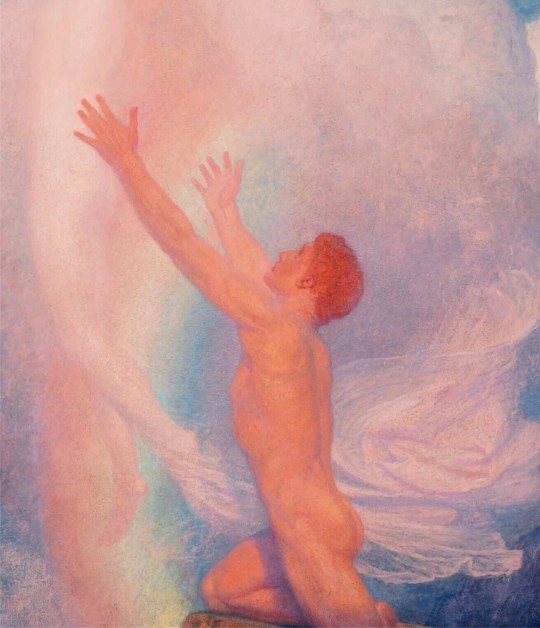
9 notes
·
View notes
Text
Gerçeklerle paralel seyreden bir dizi ideal olay vardır. Bunlar çok ender çakışırlar. İnsanlar ve rastlantılar genellikle olayların ideal seyrine müdahale edelrer, bu yüzden de olay da dolayısıyla sonuçları da ideallikten uzak, eksik görünürler. Reform hareketinde de bu böyle olmuştur. Protestanlığın yerini Luthercilik almıştır.
Novalis, Moral Ansichtn
4 notes
·
View notes
Text
Andrea Wulf – Muhteşem İsyankârlar (2024)
Bugün ayaklarımızın altındaki fikirleri oluşturmuş filozof, sanatçı ve düşünürlerden kurulu Jena Ekibi üzerine harika bir çalışma. ‘Muhteşem İsyankârlar’, Almanya’nın en parlak zihinlerinin yaşamlarını ve aşklarını ortaya koyuyor: Goethe, Schiller, Fichte, Novalis, Schlegel, Schelling ve Hegel. Küçük üniversite şehri Jena’da çevrenin merkezinde Caroline adında özgür ruhlu, üç kez evlenmiş…

View On WordPress
#2024#Andrea Wulf#Ayrıntı Yayınları#Bartu Şanlı#Friedrich Schiller#Friedrich Schlegel#Friedrich von Hardenberg (Novalis)#Friedrich Wilhelm Joseph von Schelling#Georg Wilhelm Friedrich Hegel#Johann Wolfgang von Goethe#Muhteşem İsyankârlar#İlk Romantikler ve Benin Keşfi
0 notes
Text
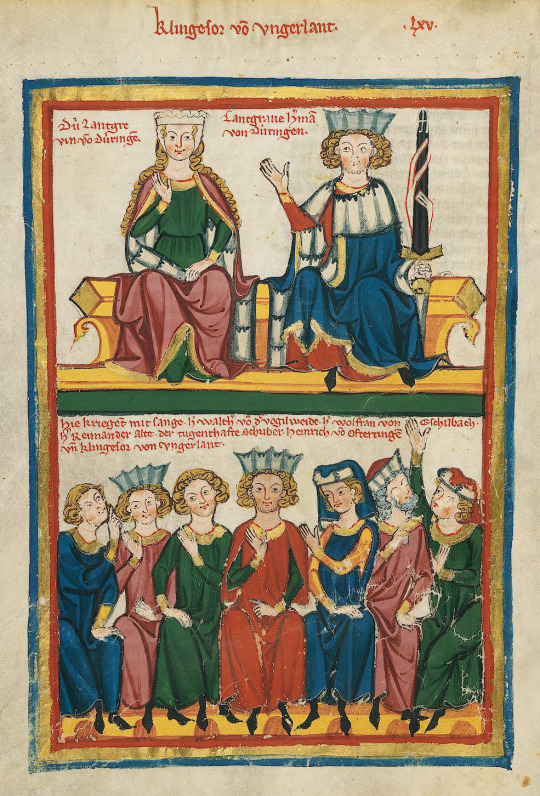
Heinrich von Ofterdingen is a fabled, quasi-fictional Middle High German lyric poet and Minnesinger mentioned in the 13th-century epic of the Sängerkrieg (minstrel contest) on the Wartburg. The legend was revived by Novalis in his eponymous fragmentary novel written in 1800.
“The spiritual worlds is in fact already open to us.
It is always open.
If we were to suddenly become so alive and supple to perceive it,
We would perceive ourselves in the midst of the spiritual world.”
Novalis
#novalis#georg philipp friedrich von hardenberg#heinrich von ofterdingen#german romanticism#fairytale#fairy tales#classic literature#german literature#fantasy#books#reading#books and reading#quotes#booklr#bookish#booksbooksbooks#literary quotes#literature quotes#book community#bibliophile#quote of the day#books and libraries#lit#book recommendations#book recs#book list#book reccs#reading list#literature#classic books
1 note
·
View note
Text
"Die Welt muss romantisiert werden. So findet man den ursprünglichen Sinn wieder."
Georg Friedrich Philipp von Hardenberg (1772-1801)
22 notes
·
View notes
Photo

Novalis, Heinrich von Ofterdingen: A Romance [originally published 1802]
#novalis#literature#heinrich von ofterdingen#words#quotes#academia#dark academia#quote#lit#books#books and libraries#reading#quote of the day#bookworm#book quotes#prose#booklr#bibliophile#excerpt#georg philipp friedrich freiherr von hardenberg#q
2K notes
·
View notes